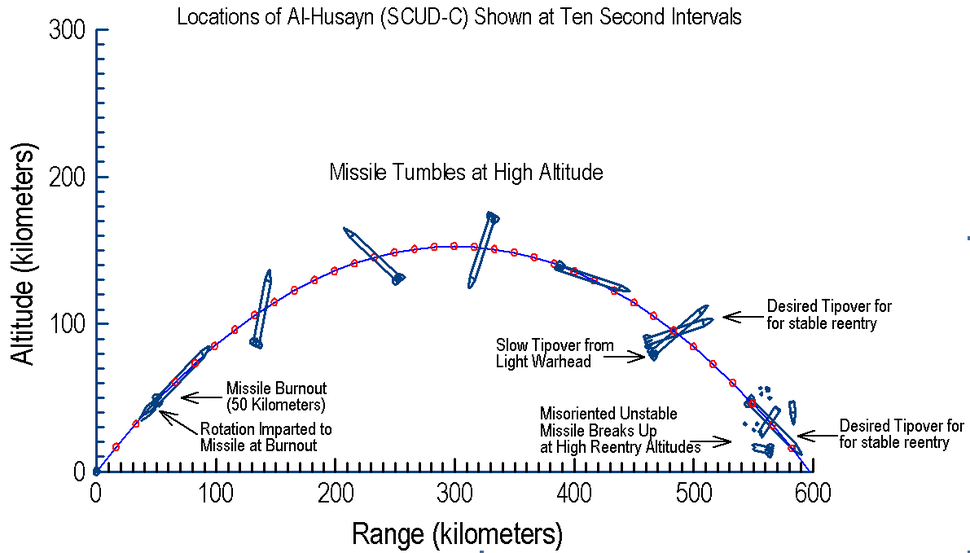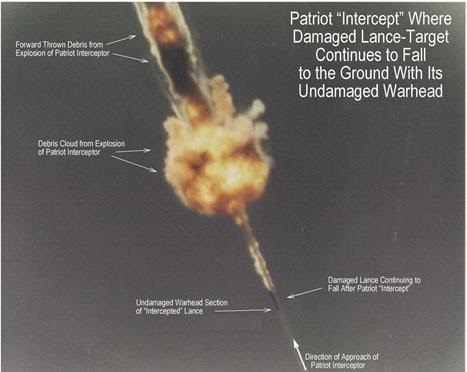 |
Free flight locations of ballistic missiles shown at 10 second intervals |
THAAD system limited in its ability to differentiate between real missiles and decoys, and to intercept tumbling and spiraling missiles
The US Missile Defense Agency (MDA) has claimed that Terminal High Altitude Aerial Defense (THAAD) interceptors have demonstrated effectiveness against short- and medium-range targets, announcing that in nine flight tests so far, THAAD intercepted all 10 target ballistic missiles.
However, the tests were conducted under circumstances that provide little, if any, information about how the THAAD interceptors would actually perform in real combat. Theodore Postol, a professor at the Massachusetts Institute of Technology (MIT), and George Lewis, a senior researcher at the Cornell University Institute of Peace and Conflict Studies, have raised questions about the MDA’s performance claims, based on three main factors.
First, North Korean ballistic missiles could fly in irregular and unstable ways on the way to targets. Due to their design, these missiles could well tumble at high altitudes and spiral at lower altitudes, as was observed in the Gulf War of 1991, and almost certainly led to the complete failure of Patriot interceptors to destroy even a single SCUD warhead in combat. Patriot interceptor tests prior to the Gulf War were successful in 17 of 17 tests. In Gulf War combat, the Patriot was almost certainly 0 for 44, defined as destruction of SCUD warheads.
Missiles tumbled in the Gulf War due to random lateral forces from rocket motors as they shut down. The motors shut down at high altitudes where the air was so thin that the fins at the back of the missiles could not prevent the tumbling. In effect, these missiles acted in flight like arrows that had no feathers. When fired from a bow, they simply tumble end over end. The low-altitude spiraling phenomena could be made intentionally by modifying the fins at the backend of missiles. Tumbling at high-altitudes happen intentionally with tiny rocket motors attached to the back of the missile that are fired as soon as the rocket’s main motor shuts down.
In addition, when the missiles reenter the atmosphere, they could be affected by aerodynamic forces. As shown in the case of Al Hussein Scud during 1991 Gulf War, if the warhead is too light to force the missile to maintain a stable orientation, lateral aerodynamic lift forces are generated that cause it to move laterally, tracing out a spiraling trajectory. The two scholars pointed out that a target following a spiraling trajectory is the most difficult target to hit.
According to their analysis, it is estimated that in the case of North Korean Scud B, the THAAD interceptor would have to be launched while the missile is still at an altitude of 60 to 70 km, where the tumbling phenomenon could occur. The spiraling movement could occur at an altitude of 10 to 20 km. In the case of Scud C, if it reenters the atmosphere in a side-on orientation it will likely remain intact until it reaches an altitude of roughly 30 km, where it will break up due to the increase in aerodynamic forces, the two scholars said. If it reenters the atmosphere oriented nose-on relative to its velocity vector, it will disintegrate at about 10 to 12km. Both of these altitudes are below the THAAD minimum intercept altitude, they said.
 |
Events during Al-Husayn(SCUD C) ballistic flight and reentry that caused low-altitude manueuvers and breakups that defeated Patriot. |
Secondly, the US missile defense systems including THAAD are limited in their capability to discriminate between the real warheads and decoys. It is because the radars and infrared sensors could tell only the exterior properties of missiles in space such as shape and brightness. Potential enemies could undermine the radars and sensors’ ability to differentiate between the warheads and decoys by conducting countermeasures including cutting a missile into many pieces using explosive cutting cords. The explosive cutting cord, which is a piece of rope manufactured from strands of high explosives, could intentionally cut the missiles into tens of fragments. If the shape of these fragments is similar to the real warheads, it is difficult to determine which one is the real warhead.
These fundamental constraints could be applied when the THAAD intercepts the Nodong missiles. Since THAAD interceptor would have to be launched while the complex of incoming objects is at an altitude of 105 km or higher, the effects of the atmosphere causing the lighter objects to slow up will be minimal, two scholars said. Hence, when the THAAD interceptor needs to be launched, there will be no way for the THAAD system to determine which of the many incoming objects would be the warhead, they said.
Proponents of missile defense systems believe that they could succeed in discriminating between the warheads and decoys by conducting more research and development in the future. However, Dr. Postol argued, “Research aimed at exploiting physical phenomena that do not exist can never produce anything but nonsense.” He said, “In effect, radars and infrared sensors see the exterior properties of objects in space. Those exterior properties can easily be manipulated so that it is fundamentally impossible to know what is beneath the exterior.”
 |
Patriot intercept where damaged Lance-target continues to fall to the ground with its indamaged warhead |
Thirdly, if the THAAD systems succeed to intercept the North Korean missiles, it must hit and destroy the front end of target-missiles exactly. However, it would be daunting challenge. The THAAD interceptor would have difficulty in homing on the part of warhead at the front of missile. For instance, in the test of SM-3 took place on July 30, 2009, the infrared sensor failed to determine where the warhead is, even two seconds prior to impact.
Postol highlighted an important difference between destroying attacking aircraft and attacking missiles. He said, “Anywhere an antiaircraft interceptor hits an airplane will likely result in either the destruction of the airplane and loss of its pilot or the inability of the aircraft to complete its mission. This means that relatively low levels of damaging against an aircraft will result in a successful outcome for the antiaircraft defense. In contrast, a ballistic missile can be heavily damaged and still succeed in its mission - delivering a warhead into the area under attack.”
He also warned, “Nuclear warheads that fly on ballistic missiles are by design very rugged. If the THAAD interceptor were to hit any part of the incoming Nodong other than the front end, the warhead could be expected to fall to the ground and detonate.”
Two scholars pointed out that most of Patriot missiles failed to hit the warhead of Iraqi Scud missiles during the Gulf War of 1991 and also SM-3 succeeded in hitting the warhead only one to two times of ten tests that they analyzed in 2009, all of which were done under exactly the same intercept conditions. The analysis on the intercept tests of THAAD is not available because their detailed results were not disclosed to the public.
The point is that North Korea is capable of developing countermeasures to avoid the THAAD interceptors. The two scholars argued that North Koreas has it well within their ability to make such countermeasures as tumbling and cutting into fragments. In particular, the technology of explosive cutting cord was demonstrated when they launched both the Taepodong-1 and the Taepodong-2 long-range ballistic missiles.
But most high-level decision-makers in the US and South Korea are not familiar with the technological details of these systems.
By Park Hyun, Washington correspondent
Please direct questions or comments to [english@hani.co.kr]

english.hani.co.kr/arti/english_edition/e_international/697543.html







